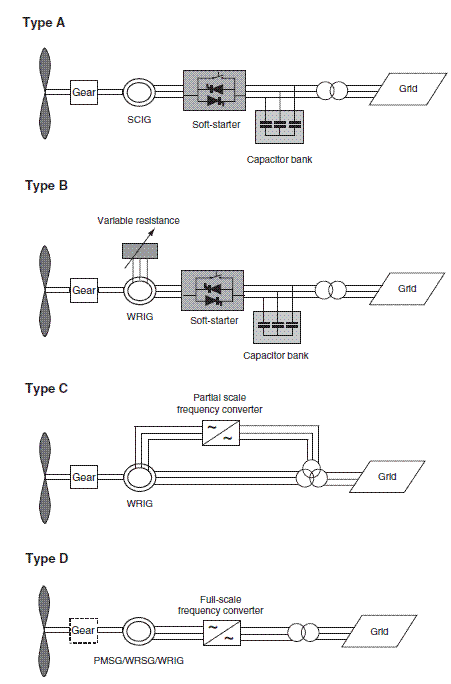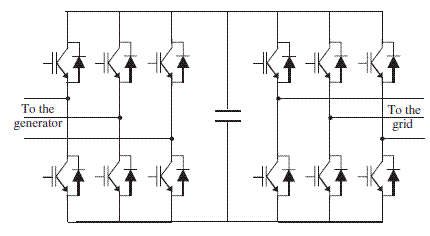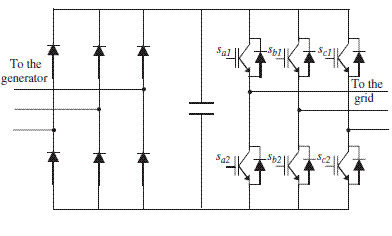- This topic has 1 reply, 1 voice, and was last updated 2 years, 11 months ago by .
-
Topic
-
What are full scale frequency converters?
Hello,
i was reading the discussion in Riddle #4 and was wondering,
what are full scale frequency converters? Is it a single device or more a system. Also where are they manufactured, and to what size? Could you show post a schematic online?
Regards
Hendrik
Viewing 1 replies (of 1 total)
Viewing 1 replies (of 1 total)
- You must be logged in to reply to this topic.

 A. Bidirectional back-to-back two-level power converter This topology is state-of-the-art especially in large DFIG based wind turbines. The back-to-back PWM-VSI is a bi-directional power converter consisting of two conventional PWM-VSCs. The topology is shown in Figure below.
A. Bidirectional back-to-back two-level power converter This topology is state-of-the-art especially in large DFIG based wind turbines. The back-to-back PWM-VSI is a bi-directional power converter consisting of two conventional PWM-VSCs. The topology is shown in Figure below.  The IGBTs on the generator-side VSC are controlled using a PWM technique (usually based on SVPWM). In variable-speed wind turbines, the frequency of the reference sinusoidal waveform is locked to the frequency of the generated voltage. Therefore, the frequency of the output voltage of the VSC contains a component at the frequency of the generated voltage, referred to as the fundamental and also higher-order harmonics. The magnitude of the VSC output voltage can be controlled by changing the amplitude modulation index and the phase angle can be controlled by controlling the phase angle of Vref with respect to the generated voltage. In order to describe the operation of the VSC connected to the generator, it is assumed that the VSC produces a sinusoidal waveform (higher-order harmonic components are neglected). As the wind turbine generator can be represented by a voltage behind a reactance (Kundur, 1994), the generator-side connection of the VSC can be represented by the equivalent circuit shown in Figure below, where VG is the magnitude of the generated voltage, VVSC is the magnitude of the VSC output voltage, ? is the phase angle between these two voltages and XG is the equivalent generator reactance.
The IGBTs on the generator-side VSC are controlled using a PWM technique (usually based on SVPWM). In variable-speed wind turbines, the frequency of the reference sinusoidal waveform is locked to the frequency of the generated voltage. Therefore, the frequency of the output voltage of the VSC contains a component at the frequency of the generated voltage, referred to as the fundamental and also higher-order harmonics. The magnitude of the VSC output voltage can be controlled by changing the amplitude modulation index and the phase angle can be controlled by controlling the phase angle of Vref with respect to the generated voltage. In order to describe the operation of the VSC connected to the generator, it is assumed that the VSC produces a sinusoidal waveform (higher-order harmonic components are neglected). As the wind turbine generator can be represented by a voltage behind a reactance (Kundur, 1994), the generator-side connection of the VSC can be represented by the equivalent circuit shown in Figure below, where VG is the magnitude of the generated voltage, VVSC is the magnitude of the VSC output voltage, ? is the phase angle between these two voltages and XG is the equivalent generator reactance.  B. Unidirectional power converter A wound rotor synchronous generator requires only a simple diode bridge rectifier for the generator side converter as shown in Figure below.
B. Unidirectional power converter A wound rotor synchronous generator requires only a simple diode bridge rectifier for the generator side converter as shown in Figure below.  The diode rectifier is the most common used topology in power electronic applications. For a three-phase system it consists of six diodes. The diode rectifier can only be used in one quadrant, it is simple and it is not possible to control it. It could be used in some applications with a DC-link. The variable speed operation of the wind turbine is achieved by using an extra power converter which feed the excitation winding. The grid side converter will offer a decoupled control of the active and reactive power delivered to the grid and also all the grid support features. These wind turbines can have a gearbox or they can be direct-driven. The same topology with an extra DC-DC conversion stage can be used for permanent magnet synchronous generators.
The diode rectifier is the most common used topology in power electronic applications. For a three-phase system it consists of six diodes. The diode rectifier can only be used in one quadrant, it is simple and it is not possible to control it. It could be used in some applications with a DC-link. The variable speed operation of the wind turbine is achieved by using an extra power converter which feed the excitation winding. The grid side converter will offer a decoupled control of the active and reactive power delivered to the grid and also all the grid support features. These wind turbines can have a gearbox or they can be direct-driven. The same topology with an extra DC-DC conversion stage can be used for permanent magnet synchronous generators.